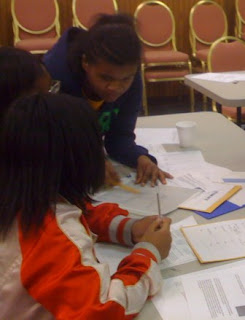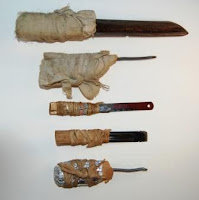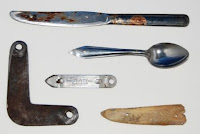We have so many interesting objects in our collections. Here are five I've selected, listed in no particular order.
 Photograph, ca. 1960. 2008.40.26. Collection of the NLEM, Washington, D.C. This image was probably used in a ca. 1960s FBI training session or lecture to illustrate the history of the use of fingerprinting in law enforcement.
Photograph, ca. 1960. 2008.40.26. Collection of the NLEM, Washington, D.C. This image was probably used in a ca. 1960s FBI training session or lecture to illustrate the history of the use of fingerprinting in law enforcement.
1) “West Brothers” – Photograph, 1903. A case of mistaken identity at Leavenworth. The early years of the 20th century witnessed a transition from the Bertillon Measurement system, a process of identifying criminals based on measurement of anthropomorphic characteristics such as skull, arm, and leg measurements, as well as recording marks on the body, to the acceptance of fingerprints as unique identifiers of individuals.
The case of the “West Brothers” is particularly illustrative of the reliability of fingerprinting over Bertillon Measurements. In 1903, Will West was committed to the penitentiary at Leavenworth, Kansas, where he was photographed and measured using Bertillon methods. Will West’s measurements were found to be almost identical to a criminal at the same penitentiary named William West, who was committed for murder in 1901 and was serving a life sentence. Furthermore, their photographs showed the two men to bear a close physical resemblance to one another, although it was not clear that they were even related. In the ensuing confusion when the identities of the two men were being confirmed, their fingerprints conclusively identified them and demonstrated clearly that the adoption of a fingerprint identification system was more reliable than the older Bertillon method.
2) Robocop 2 suit, 1990 (image coming soon). Just because it’s Robocop…and cool. This sci-fi action film is a sequel to the 1987 movie Robocop, a cinematic vision of law enforcement set in the near future. The Robocop saga is based on the tale of a law enforcement officer, played by actor Peter Weller, who was killed then resurrected as a cyborg entity programmed to fight crime. According to a 2002 Dutch-language interview with director Paul Verhoeven, the Robocop character was based on comic book action hero Judge Dredd and was inspired by the futuristic film Blade Runner. The successful Robocop franchise includes two sequels, branded merchandise, an animated television series, and comic book adaptations.
 Identi-Kit, Model II, Smith and Wesson, ca. 1976. 2009.4.18. Collection of the NLEM, Washington, D.C. Composite images created from many different facial components were assembled by hand to produce an image of a criminal suspect.
Identi-Kit, Model II, Smith and Wesson, ca. 1976. 2009.4.18. Collection of the NLEM, Washington, D.C. Composite images created from many different facial components were assembled by hand to produce an image of a criminal suspect.
 A composite image created from randomly selected foils from the 1976 Identi-Kit Model II. Do you know who this is?
A composite image created from randomly selected foils from the 1976 Identi-Kit Model II. Do you know who this is?
3) Identi-Kit Model II, Smith and Wesson, 1976. A reminder that things weren't always as easy as they are today. The Identi-Kit Model II is the second iteration of a composite facial feature reconstruction process used by police departments to help identify criminal suspects. First produced in 1959, the original Identi-Kit consisted of hand drawn facial feature components which were mounted on transparencies called “foils.” Individual foils were layered atop one another to create a face, which was then mechanically copied and circulated to aid in suspect identification. The Identi-Kit in the NLEM collection is the second version, which was developed in 1976 and contains photographic, rather than hand-drawn, facial features mounted on foils. In 1989, the first software version, Identi-Kit Model III, was introduced and its Internet-based use continues today by law enforcement agencies.
 Lunch box, Adam-12, ca. 1973. 2007.43.163. Collection of the NLEM, Washington, D.C.
Lunch box, Adam-12, ca. 1973. 2007.43.163. Collection of the NLEM, Washington, D.C.
4) Lunchbox, Adam-12, 1973. People of a certain age will remember not only the television show Adam-12, but also the status of carrying a lunch box with colorful depictions of these fictional law enforcement heroes to school. Jack Webb, of Dragnet fame, produced this popular television series, which ran from 1968 to 1975. The show was based on the experiences of Los Angeles Police Department officers and strove “for absolute authenticity as far as police technique and procedure is concerned.” Starring Kent McCord as Officer Jim Reed and Martin Milner as Officer Pete Malloy, the worn metal lunch box depicts exciting scenes from the show: apprehending dangerous criminals in dark alleys, the tension of speeding toward a call, and community-friendly interactions with children and puppies. The lunchbox was originally produced with a matching thermos, missing from the artifact in the NLEM collection.
 Traffix Accident Reporting Kit, Forbes Stamp Company, unknown date. 2008.26.15. Collection of the NLEM, Washington, D.C.
Traffix Accident Reporting Kit, Forbes Stamp Company, unknown date. 2008.26.15. Collection of the NLEM, Washington, D.C.
5) Forbes Traffix Handy Accident Reporting Kit, unknown date. This unique kit contains 18 wooden and rubber stamps with a variety of vehicle illustrations, including cars, trucks, bicycles, and various combinations of these vehicles, presumably to illustrate traffic accident situations for reporting purposes. This intriguing artifact is missing documentation and the ink pad, and may date from before 1940. The kit is, however, accompanied by a c. 1960 instruction booklet, published by the Traffic Institute of Northwestern University in Evanston, IL, about how to use traffic template kits, although it is not clear that the Forbes kit and the booklet are related. Research still needs to be completed on this artifact, and it will be fun to track down the history of this kit and its manufacturer, the Forbes Stamp Company. If you have any information about the Forbes Traffix Handy Accident Reporting Kit, or about the Forbes Stamp Company, please contact the Museum.

























